Day 3: Tuscania-Orbetello
The weather is pretty nice this morning....cloudy but with patches of blue sky. After breakfast, we pack up but before we leave town we take a stroll around Tuscania. We make a circle through some of the business areas and residential areas, then to some of the "official piazzas" and historical monuments. The town is very attractive and very pleasant....flowers on the facades of buildings and in window boxes. The street lamps are very distinctive and there are many fountains to admire.
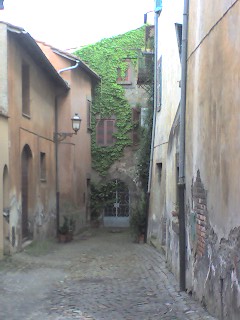

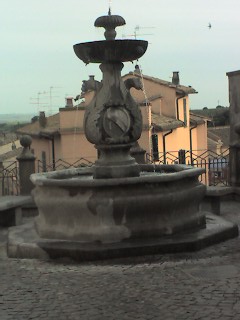
The main government square is ringed with impressive palazzi and a wall topped with a row of Etruscan sarcophagi.

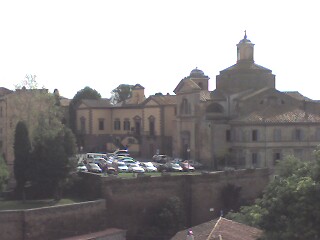
The town has extremely good "vibes" and it is a place where we would be happy to return.
Our next to last stop in Tuscania is the Archaelogical Museum, which is housed in the former convent of Santa Maria di Riposo. The museum has an excellent collection of local Etruscan finds--a smaller version of the museum in Tarquinia. The artifacts reinforce our positive feelings about the Etruscan civilization which flourished in the centuries before the Roman Empire and was a major trading partner with Greece at the height of its power. The wealth of the Etruscans was due to the discovery of iron ore on Elba which they produced and sold....ending up with a treasure trove of the Greek and Greek-influenced possessions which are among the items on display in the museums.
These are but a few of the sarcophagi on display at the Tuscania museum--some in carved in stone and others made of terra cotta.
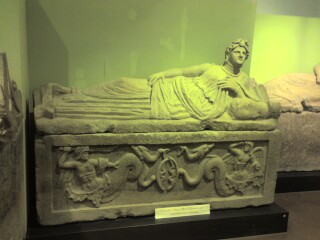

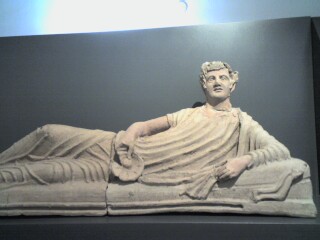
There is also a pretty well preserved fresco cycle illustrating events from the life of Saint Francis painted on the walls of the cloister of the former monastery. All in all, an excellent museum....and free admission......
We drive out to the very imposing Basilica of San Pietro which is now about 1 km from the main part of town.....it dates from the 11th century and has a impressive carved facade and intricate rose window on the outside, and inside, a beautiful cosmatesque floor, high pointed arches and austere decorations
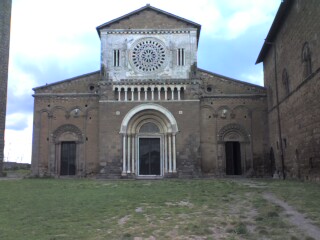
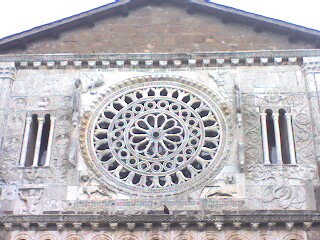
as well as a nice crypt on the lower floor with graceful columns and some well preserved frescoes.
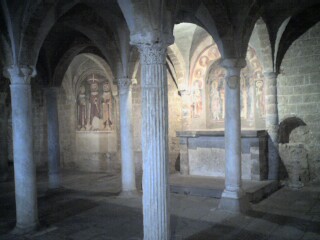
We take a somewhat roundabout route to Orbetello, through the gently rolling hills and green fields of this very sparsely populated northwest corner of Lazio. In addition to the red poppies, spring wild flowers, yellow broom, and fennel growing along the roadside are everywhere to be seen. We stop in Farnese, formerly the seat of the famous family, but today a quiet provincial town. The main square is crossed by an ancient acqueduct
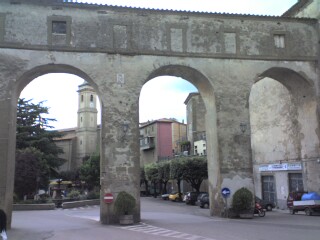
and the main tourist attraction that we find is a sign that explains the "Route of the Brigands", which traces the history and describes the exploits of the infamous robbers that ran wild in the area in the 19th century. The sign admonishes us not to romanticize them - it says they were not Robin Hoods.
The restaurant where we plan are to have lunch is unfortunately only open in the evening. We are lucky to duck into an alimentari just before it closes for lunch at 1:15 and they make us a couple of sandwiches that we take with us in the car to eat at our next stop. Diana remarks that I shouldn't hope to find a roadside picnic table--we have found very few in our Italian travels--when, around the next bend, one appears. We stop and eat our sandwiches.
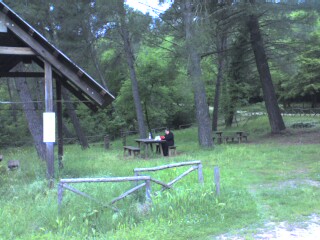
We soon cross the border that separates Lazio from Tuscany and the scenery dramatically changes. While in Lazio, the gentle rolling countryside was very pleasant, once in Tuscany it becomes more beautiful with very pleasing sweeping vistas. And the view of the town Manciano atop its hill is very different than anything that we had seen in Lazio.
Orbetello is a small city that is located on one of the causeways that link the Argentario (an island) to the mainland of Italy. It is completely surrounded by water and is only about seven blocks across at its widest point.
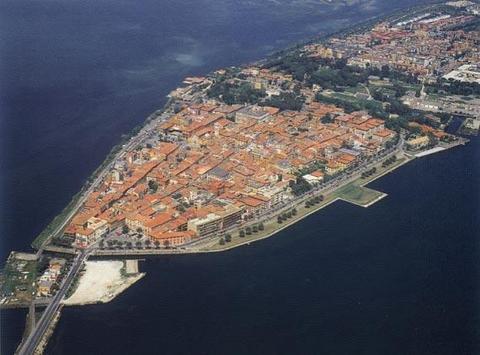
The hotel--the Relais Sanbiagio--is located right in the middle of town and is quite nice....we are given a suite with a sleeping loft, nice furniture and two bathrooms. And...as an added bonus...there is high speed internet access.
After getting settled and doing some work, we head out to explore a bit of the town. The town was under Spanish control from 1550 to 1700 and it still has something of a Spanish feel to it. We walk for a while on the main street, window shop and stop for a gelato. We then get in the car and take the short ride to the Argentario peninsula where we drive to the town of Porto Ercole, a densely populated resort town which doesn't impress much on first impression.

We also make a stop on the beach at Feniglia (this is where Caravaggio died) which is a long stretch of beach on the third causeway that connects the Argenatario to the mainland.
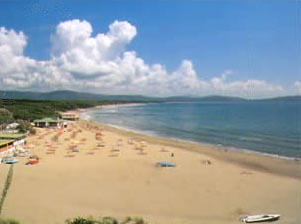
Most everything is closed up (it is still very off season) but the beach looks very nice, although a lot of buildings (shacks??) visible through the fences look like they are pretty run down.
We have dinner at the close by Vecchia Cantina--recommended by Robert Rainey of the Slow Travel message board--and it is very good. Diana has dish of spaghetti with spernocchie (a local term for a type of shrimp)--deliciously sweet but impossibly messy to eat- followed by
the best carpaccio (made with Chianina beef) that we have ever had. I have a great antipasto toscana--prosciutto, salumi, etc.--and a wonderful dish of pappardelle with a boar ragu. We both have panna cotta for dessert, which is very pleasant. We manage to drink a whole liter of the fine house red. The bill comes to Euro 51.00..a good value...and we enjoy our short walk back to the hotel.
Tomorrow we plan to visit Talamone, a small fishing village on the mainland.



The main government square is ringed with impressive palazzi and a wall topped with a row of Etruscan sarcophagi.


The town has extremely good "vibes" and it is a place where we would be happy to return.
Our next to last stop in Tuscania is the Archaelogical Museum, which is housed in the former convent of Santa Maria di Riposo. The museum has an excellent collection of local Etruscan finds--a smaller version of the museum in Tarquinia. The artifacts reinforce our positive feelings about the Etruscan civilization which flourished in the centuries before the Roman Empire and was a major trading partner with Greece at the height of its power. The wealth of the Etruscans was due to the discovery of iron ore on Elba which they produced and sold....ending up with a treasure trove of the Greek and Greek-influenced possessions which are among the items on display in the museums.
These are but a few of the sarcophagi on display at the Tuscania museum--some in carved in stone and others made of terra cotta.



There is also a pretty well preserved fresco cycle illustrating events from the life of Saint Francis painted on the walls of the cloister of the former monastery. All in all, an excellent museum....and free admission......
We drive out to the very imposing Basilica of San Pietro which is now about 1 km from the main part of town.....it dates from the 11th century and has a impressive carved facade and intricate rose window on the outside, and inside, a beautiful cosmatesque floor, high pointed arches and austere decorations


as well as a nice crypt on the lower floor with graceful columns and some well preserved frescoes.

We take a somewhat roundabout route to Orbetello, through the gently rolling hills and green fields of this very sparsely populated northwest corner of Lazio. In addition to the red poppies, spring wild flowers, yellow broom, and fennel growing along the roadside are everywhere to be seen. We stop in Farnese, formerly the seat of the famous family, but today a quiet provincial town. The main square is crossed by an ancient acqueduct

and the main tourist attraction that we find is a sign that explains the "Route of the Brigands", which traces the history and describes the exploits of the infamous robbers that ran wild in the area in the 19th century. The sign admonishes us not to romanticize them - it says they were not Robin Hoods.
The restaurant where we plan are to have lunch is unfortunately only open in the evening. We are lucky to duck into an alimentari just before it closes for lunch at 1:15 and they make us a couple of sandwiches that we take with us in the car to eat at our next stop. Diana remarks that I shouldn't hope to find a roadside picnic table--we have found very few in our Italian travels--when, around the next bend, one appears. We stop and eat our sandwiches.

We soon cross the border that separates Lazio from Tuscany and the scenery dramatically changes. While in Lazio, the gentle rolling countryside was very pleasant, once in Tuscany it becomes more beautiful with very pleasing sweeping vistas. And the view of the town Manciano atop its hill is very different than anything that we had seen in Lazio.
Orbetello is a small city that is located on one of the causeways that link the Argentario (an island) to the mainland of Italy. It is completely surrounded by water and is only about seven blocks across at its widest point.

The hotel--the Relais Sanbiagio--is located right in the middle of town and is quite nice....we are given a suite with a sleeping loft, nice furniture and two bathrooms. And...as an added bonus...there is high speed internet access.
After getting settled and doing some work, we head out to explore a bit of the town. The town was under Spanish control from 1550 to 1700 and it still has something of a Spanish feel to it. We walk for a while on the main street, window shop and stop for a gelato. We then get in the car and take the short ride to the Argentario peninsula where we drive to the town of Porto Ercole, a densely populated resort town which doesn't impress much on first impression.

We also make a stop on the beach at Feniglia (this is where Caravaggio died) which is a long stretch of beach on the third causeway that connects the Argenatario to the mainland.

Most everything is closed up (it is still very off season) but the beach looks very nice, although a lot of buildings (shacks??) visible through the fences look like they are pretty run down.
We have dinner at the close by Vecchia Cantina--recommended by Robert Rainey of the Slow Travel message board--and it is very good. Diana has dish of spaghetti with spernocchie (a local term for a type of shrimp)--deliciously sweet but impossibly messy to eat- followed by
the best carpaccio (made with Chianina beef) that we have ever had. I have a great antipasto toscana--prosciutto, salumi, etc.--and a wonderful dish of pappardelle with a boar ragu. We both have panna cotta for dessert, which is very pleasant. We manage to drink a whole liter of the fine house red. The bill comes to Euro 51.00..a good value...and we enjoy our short walk back to the hotel.
Tomorrow we plan to visit Talamone, a small fishing village on the mainland.
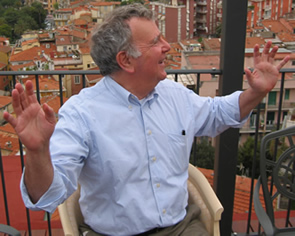

0 Comments:
Post a Comment
<< Home